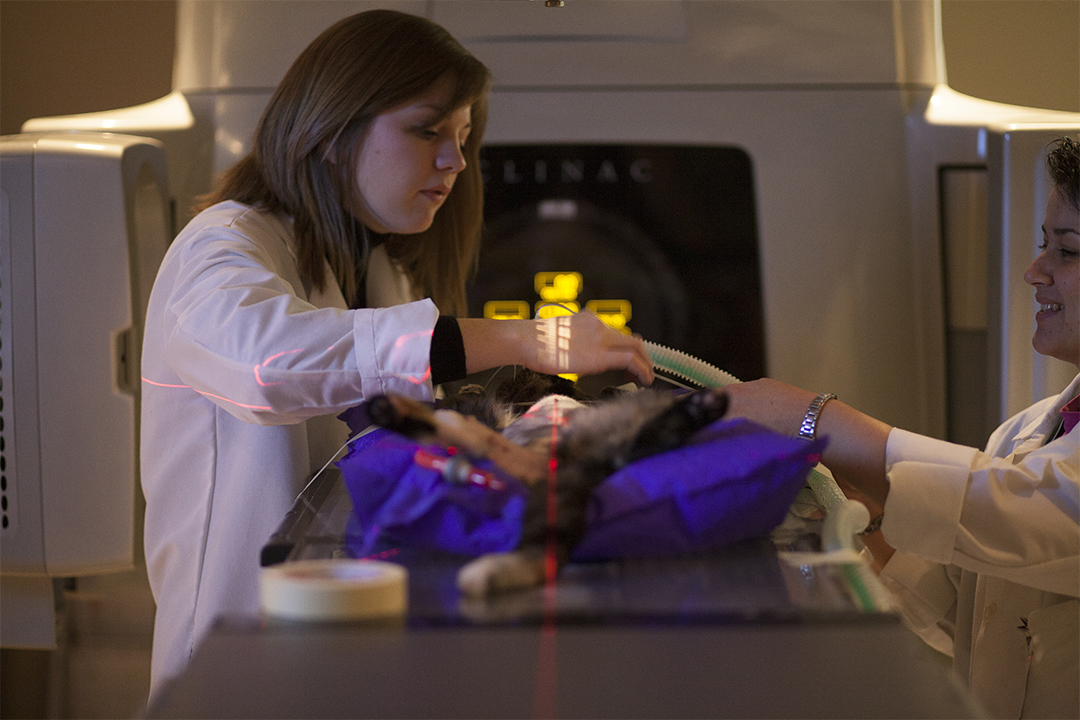
Rapid radiation
State-of-the-art radiation technology is transforming cancer treatment at the Western College of Veterinary Medicine (WCVM).
By Kathy FitzpatrickKnown by its trade name RapidArc, volumetric arc therapy is an advanced form of intensity-modulated radiotherapy (IMRT) that beams radiation to the targeted tumour with unmatched precision and speed.
The veterinary college installed the RapidArc software in its pet radiation therapy centre earlier this year. Two anonymous donors contributed more than $500,000 to purchase the new technology.
“It’s a treatment tool that we simply couldn’t have afforded without the generosity of these two donors,” says Jennifer Molloy, director of development at the WCVM.
Since the college already had a linear accelerator capable of accommodating RapidArc, the new technology required very little additional hardware. It was really a matter of “just sort of turning on things and adjusting things,” says Dr. Monique Mayer, professor of radiation oncology at the WCVM.
Previously, radiation treatment was delivered through several precisely-aimed beams, each from a different set angle. In conventional IMRT treatments, the machine must rotate several times around the patient or make repeated “stops and starts” to treat the tumour from several different angles.
In contrast, RapidArc delivers treatment as the beam rotates around patients, explains Mayer.
“So instead of 10 or 12 beams, you basically have an infinite number of beams coming from every angle. And that allows you to target the tumour even more accurately.”
The technology literally is cutting edge when it comes to slicing out tumours. The radiation dose can be programmed to target the exact outline of the tumour – even an irregularly-shaped one. This is critically important in ensuring that none of the tumour is missed and normal tissue is spared.
In the case of a brain tumour, this hyper-precision could mean the difference between causing and preventing lasting impairment. Or with a nasal tumour situated very close to the eyes, it may spell the difference between losing and preserving vision.
Future research at WCVM may help to pinpoint exactly how much more accurately RapidArc covers tumours than the previous standard of care, Mayer says.
As for speed, because RapidArc eliminates the need to stop and move the angle of the beam, an oncology team can deliver radiation treatment to a patient much more quickly – up to eight times faster than what was previously possible. Typically, it takes less than two minutes for RapidArc to deliver the dose to the entire tumour in a 360-degree rotation.
Such precise targeting of tumours permits the use of stereotactic radiation therapy that delivers higher doses of radiation — but fewer of them. The result: treatments can be done in three days instead of the standard 20 to 25 days. Small tumours may require only one radiation treatment.
“So it’s a huge difference for families and the animals that have to be under anesthetic for every treatment. It’s like night and day for them. They can come in and have three treatments— or sometimes even one — and be done versus four weeks away from their family … because we’re so far away from a lot of our clients,” Mayer says.
It’s stressful for animals to undergo general anesthetic, partly because they must fast overnight. While a young child may grasp why an evening snack is off the menu, try explaining that to Fido or Fluffy. The fewer times the procedure must be repeated, the easier it is on the animals, their owners and their caregivers.
Helping to make life easier for pets with cancer and their families was a motivating factor for both donors whose gifts were used to purchase RapidArc, adds Molloy.
“What really appealed to them was the fact that this new technology dramatically reduces the amount of time that pets have to stay at the WCVM for radiation therapy. RapidArc is delivering much more precise, effective therapy for our oncology patients — plus it’s helping to cut down on the worry for families.”
Radiation therapist Rachel Bloomfield finds another advantage to having patients on the treatment table for a shorter time period: less chance of the patient moving during treatment. Even though everyone keeps a close eye on everything, there have been a couple of times when the patient has woken up halfway through radiation therapy. When that happens, the team needs to reposition the patient and re-image.
As well, the patients are often older with other illnesses such as heart or liver problems that make general anesthesia even riskier.
Although planning treatments is a little more complicated and can take longer with RapidArc than with convention IMRT, Bloomfield says having a shorter treatment time is worth it.
There are times when a second round of radiation treatment is required. Bloomfield says with RapidArc she is still able to deliver a high dose of radiation to the tumour that second time around because “the dose will ‘hug’ the tumour a lot closer.”
For Mayer, the attraction of RapidArc lies in the opportunity to give cancer patients the best level of care.
She already knows that the outcome of stereotactic radiation, made possible with RapidArc, has been shown to be as good as or possibly better than standard radiation treatments.
She also knows that certain types of tumours can be cured with radiation. Others have a higher risk of recurrence, but “we know we can give [patients] one and a half or two years of good quality of life.”
Kathy Fitzpatrick is a freelance journalist in Saskatoon. Born in Manitoba, she has spent close to four decades working in media — including radio, television, print and digital.
